Around the middle of the first century BC, as the Roman Republic teetered on the brink of collapse, a magnificent villa was constructed on the north-eastern coast of the Bay of Naples. Covering an area of more than 6,000 square metres, and incorporating a swimming pool, two peristyle gardens with fountains, and a circular belvedere with views across the bay, it was a bolthole that would have made even Berlusconi jealous. Among its luxurious delights, or deliciae as the Romans called them, were trompe l’oeil wall paintings, some 90 bronze and marble statues, polychrome mosaics and an extensive library. The identity of the villa’s original owner is disputed, but he must have been a Roman of high social standing, sophisticated tastes and abundant means.
Unfortunately for its last occupants, but fortunately for the historical record, the villa was on the edge of Herculaneum. When Vesuvius erupted in 79 AD, the town was buried by volcanic debris, which also accumulated along the coast, pushing the shoreline farther out. Today the Villa dei Papiri, as it is known, is a partially excavated site, the remainder of which lies hidden beneath the modern town of Ercolano. To experience something of how it might have been in the first century BC, you have to go to the Getty Villa near Malibu, a 20th-century reconstruction by a man of comparable wealth and influence to the owner of the original. This summer, the Getty Villa will be the fitting site of an exhibition of the original villa’s treasures, including both works of art and papyrus rolls. ‘Buried by Vesuvius: Treasures from the Villa dei Papiri’ (26 June–28 October) will explore what connections there may be between the villa’s decorative scheme and the contents of its library – which were rather unexpected.
The Villa dei Papiri was rediscovered by well diggers in 1750, a few years after the ancient site of Herculaneum. A team of military engineers sponsored by Charles VII, King of the Two Sicilies, bored tunnels down through 27 metres of solidified rubble to rooms where they discovered a hoard of antiques. These were as much a status symbol in the 18th century as they had been in the first century BC. The workers dug up their finds, in pieces if necessary, and carted them away to the Royal Herculaneum Museum, a new wing of the king’s summer palace in nearby Portici. The discoveries included heaps of shattered statues, their limbs never to be reassembled, frescoes cut from their walls and, remarkably, more than a thousand papyrus rolls containing Greek and Latin texts.
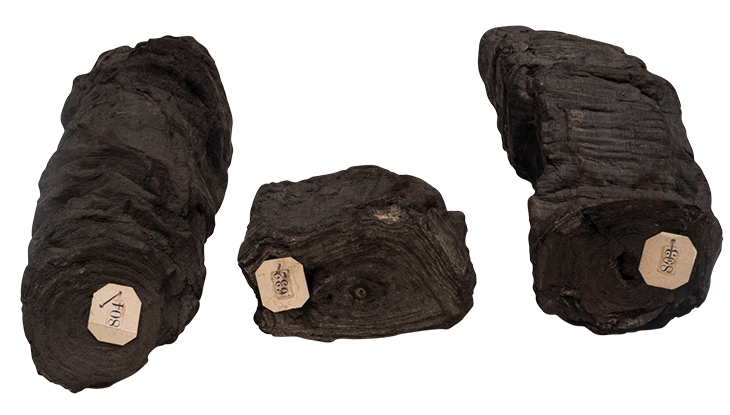
Three carbonised scrolls (2nd century BC–1st century AD), recovered from the Villa dei Papiri, Herculaneum, between 1752–54. Biblioteca Nazionale di Napoli. All Rights Reserved. All other use prohibited. Su concessione del Ministero per i Beni e le Attività Culturali
The rolls, which had been carbonised by superheated gas and rubble, were at first mistaken for logs and used as firewood, or chopped up and reburied. This stopped when one was broken open and writing discovered on the inside. Together, these papyri constitute the only literary library to have survived from the ancient world. Great was the disappointment of the cultured classes of Europe, however, when fragments of the papyri were read, revealing not the lost works of Pindar or Aristotle, but the professional library of an obscure Greek poet and Epicurean philosopher called Philodemus, who died around 40 BC. The texts deciphered so far include Philodemus’s writings on ethics and logic, and Epicurus’s own magnum opus: a theory of natural philosophy in 37 tortuous volumes.
How did the library of a minor Greek philosopher come to be located in the holiday home of a Roman aristocrat? Theories abound; much of the villa remains unexcavated, and there are many gaps in the evidence. A small but arguably important clue, however, lies in the dedication of one of Philodemus’s treatises to Lucius Calpurnius Piso Caesoninus. Piso, who was probably Philodemus’s patron, was one of the grandees of the late Republic, and father-in-law to Julius Caesar. We learn from Cicero that Philodemus was constantly at Piso’s side, and instructed him in Epicureanism. He may even have lived for some time at Piso’s home, perhaps in Herculaneum. A tame philosopher could be as much of a symbol of cultural refinement as an art collection, and Piso was not the only Roman nobleman to have one in his entourage; Cicero had a similar arrangement with Diodotus, a Stoic.
The discovery of Philodemus’s library, and the dedication to Piso, suggests that the latter may have been the owner of the Villa dei Papiri. If Piso fits the bill, and if he studied Epicureanism at the villa, this raises an intriguing question: were the villa’s artworks intended to reflect their owner’s Epicurean beliefs – and how far were those beliefs compatible with the lifestyle of a wealthy Roman statesman?
That lifestyle would certainly have been luxurious. The villa is a particularly splendid example of the type of ‘pseudo-urban’ mansion in which the sophisticated Roman elite spent their otium, or leisure time, when they wanted to have a break from politics and business in the city. From the first century BC until the eruption of Vesuvius, a string of such mansions was built along the Bay of Naples, an area of sunlit glamour which Cicero called ‘that voluptuous mixing-bowl’.
The art collection at the villa testifies to the strong Greek influence on the Roman dolce vita. After they sacked Corinth in 146 BC, the Romans became the dominant force in mainland Greece. From this time onwards, Greek culture, as Horace put it, captivated its captor, and ‘introduced the arts to uncultivated Latium’. Greek artworks, purchased or plundered, moved steadily into Roman homes, while the taste for ‘Asiatic luxury’ was imported from the Hellenistic rulers of Egypt. The villa’s collection of statues, frescoes and other furnishings includes both original Greek artworks and Greek and Roman reproductions of Greek originals. They testify to the thriving trade in art across the Mediterranean at the time when the villa was built.
The study of philosophy, like the collecting of sculpture, was a valued aspect of Roman otium, and one imported from Greece. Even the association between free time and study was a Greek import: the concept of the philosophical ‘school’ derives from scholê – the Greek for ‘leisure’. Philodemus, one of many Greek philosophers to emigrate to Italy, was conscious of catering to a demand in the cultural market. In one of his treatises, he claims that the best way of earning a living is by ‘receiving thankful gifts in return for philosophical discourses with men capable of understanding them’ – such as Piso.
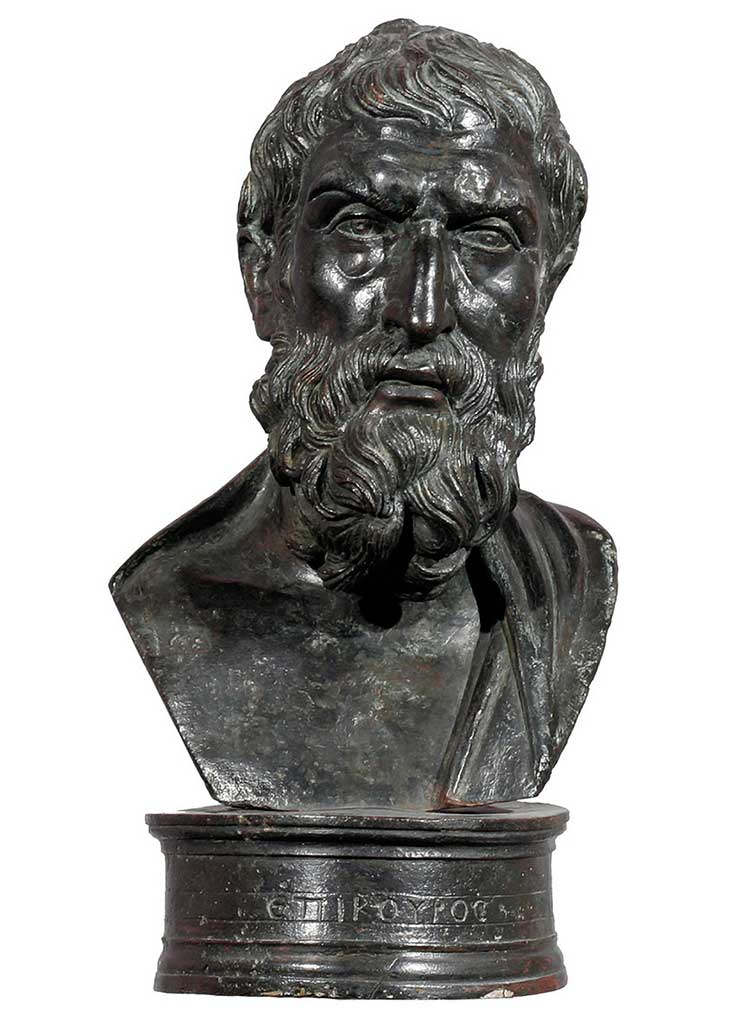
Bust of Epicurus (1st century BC–1st century AD), Roman. Photo: Giorgio Albano; courtesy Museo Archeologico Nazionale di Napoli
The villa’s owner clearly spent part of his otium engaged in study of Epicurean philosophy – or at least wanted to convey that impression. Multiple copies of bronze busts of Epicurus and his colleague Hermarchus have been discovered, at least two of them in rooms with papyrus rolls. The Epicureans were well known for surrounding themselves with images of their founder, in pictures and on cups and rings; by contemplating his serene countenance, they hoped to bring their state of mind closer to his. In their new Roman context, the busts would also have celebrated the intellectual life of their owner.
Epicurus had founded his school in Athens in around 300 BC. He had argued that the universe consists of nothing but indivisible particles (‘atoms’) and empty space. Happiness, and the proper goal of human life, consists in pleasure, by which he meant the tranquillity (ataraxia) of mind and body which arises when our mental and physical wants are satisfied. He stressed that the highest pleasures are friendship and philosophical contemplation, but is also recorded as saying that ‘the beginning and root of all good is the pleasure of the stomach’.
Based on uncharitable interpretations of remarks like these, the Epicureans, both Greek and Roman, were often accused of being nothing more than hedonists, devoted to the transient pleasures of the flesh – in particular, to gluttony. This charge was still being repeated long after the eruption of Vesuvius: at the turn of the second century, Plutarch accused Epicurus of obsessively recalling his ‘sumptuous dinners’, while Athenaeus, in his third-century narrative Scholars at the Dinner Table, describes how an Epicurean character wolfs down an eel before anyone else can touch it.
The ease with which the Epicurean pursuit of tranquillity could be elided with the hedonistic indulgence of the senses was exploited by Cicero in a speech against Piso, his personal enemy. Cicero accuses Piso of adopting Epicureanism simply because he has ‘heard pleasure praised by a philosopher’, and seizes on it as an excuse for debauchery. Cicero contrasts Piso unfavourably with his ‘Greekling’, Philodemus, who he concedes is cultivated and writes witty verses. Philodemus’s learned accomplishments, Cicero observes sarcastically, distinguish him from most Epicureans. In addition to gluttony, the school had a reputation for boorishness, which derived from another notorious maxim of Epicurus: ‘Hoist sail and steer clear of all culture.’
Drawing on the Epicureans’ reputation for gluttony and boorishness, Cicero attacks Piso for living in a way which, although it is extravagant, does not conform to the cultural standards of a man of his high station – the sort of man who lived at the Villa dei Papiri. Piso allegedly prefers the ‘pleasures of the stomach’ to those of the eyes and ears. He has no embossed silver, but only ‘enormous drinking cups’; instead of shellfish (another delicacy), he serves half-rancid meat; and his wine comes from the common barrel rather than from a private cellar. In other words, Piso has the sensual appetites of an Epicurean, unrefined by the tastes of an aristocrat. These tastes were both exotic and expensive – as will be shown this summer in an exhibition devoted to the Romans’ eating habits, at the Ashmolean Museum, Oxford (‘Last Supper in Pompeii’, until 12 January 2020).
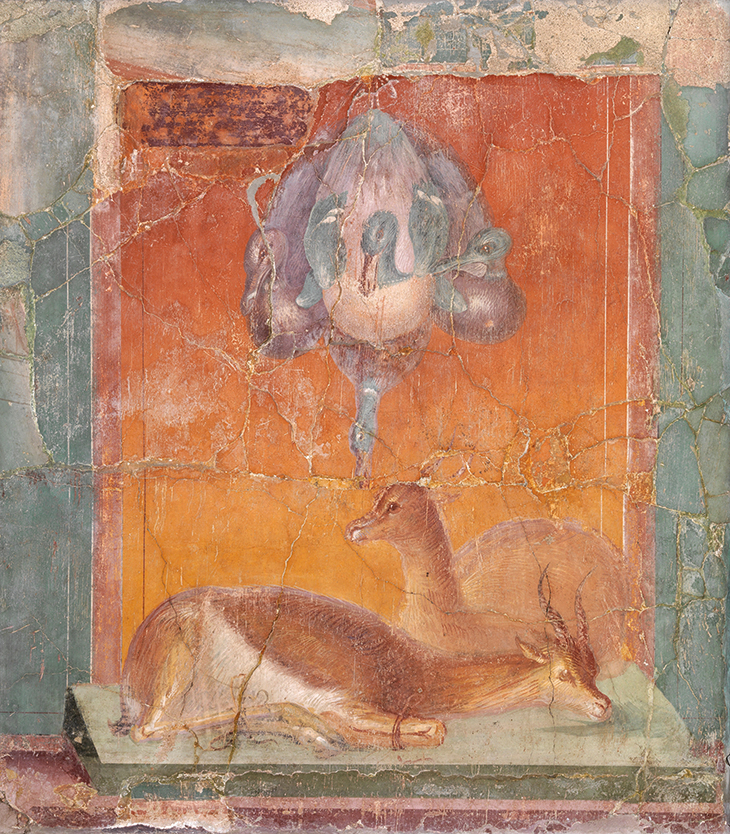
Fresco with ducks and deer (c. 40 BC), Roman. Photo: Giorgio Albano; courtesy Museo Archeologico Nazionale di Napoli
The artworks discovered at the villa certainly do not suggest that their owner was an unsophisticated glutton. Nevertheless, some of them may contain Epicurean – or hedonistic – overtones. One example is a fresco, dating to around 40 BC, of ducks and deer ready to be killed and eaten. The ducks dangle from the ceiling, one with its head drooping despondently; one of the deer rests its head on the floor, its legs pathetically trussed. The fresco is an example of a Greek genre called xenia (‘hospitality’) paintings: still lifes representing exotic displays of food, which were used to emphasise the host’s munificence. However, this painting, in addition to its generic function, may also – viewed in an Epicurean light – refer to the tranquillity which can come from the satisfaction of hunger. Or perhaps it is simply hedonistic.
In fact, some Roman students of Epicurus may not have been too interested in subtle distinctions between pleasure as a means and as an end. This is suggested by the discovery, in a corner of the villa’s larger peristyle garden, of a small bronze statue of a one-month-old female piglet. Despite not being the usual subject of an objet d’art, the piglet is elegantly cast, her front hooves raised, her ears flattened back along her head and her tail coiled up playfully. This statue may be a self-deprecating, or even self-indulgent, allusion to the Epicureans, whom their opponents regularly compared to pigs, the animals most naturally associated with gluttonous eating. (Cicero calls Piso an ‘Epicurus from the pigsty’.)
This interpretation of the piglet is further supported by a pair of silver cups unearthed nearby at Boscoreale. These depict skeletons at a symposium, each representing a Greek philosopher or poet. One skeleton, labelled ‘Zeno’ (founder of Stoicism), leans on a staff as he disputes with another skeleton labelled ‘Epicurus’, who takes some food from a table. At his feet, a pig raises its snout up towards the food. Above the table is the inscription ‘pleasure is the goal of life’. Once again, Epicurus’s lofty ideas about tranquillity are ignored: pleasure is about food and drink.
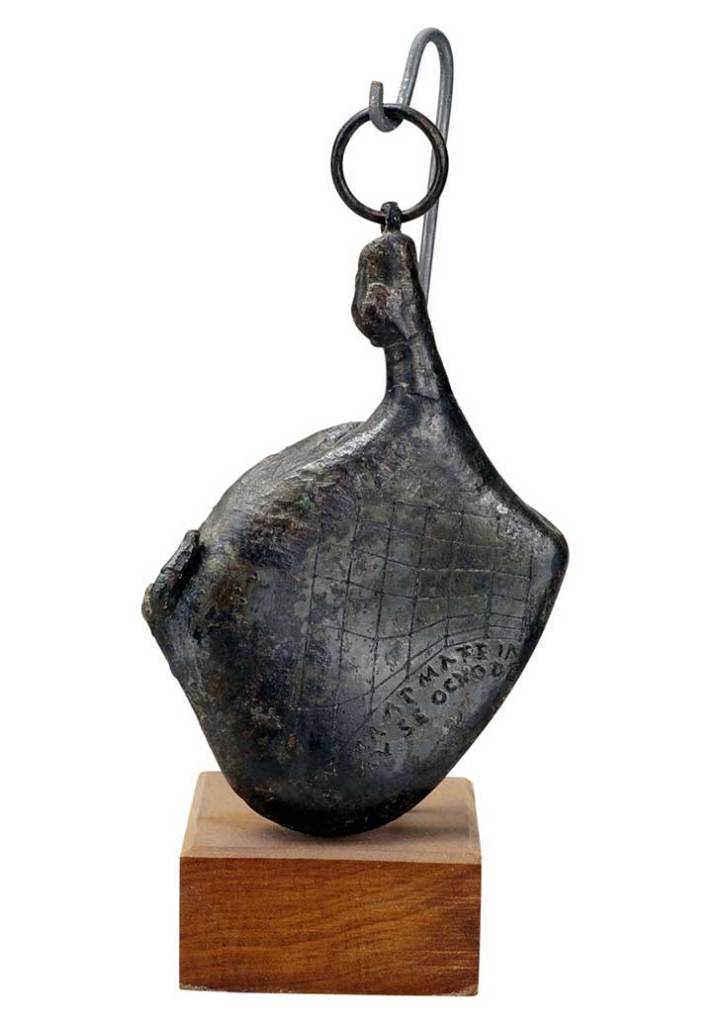
Portable sundial in the shape of a ham (1st century BC–1st century AD), Roman. Photo: Luigi Spina; courtesy Museo Archeologico Nazionale di Napoli
If the piglet at the Villa dei Papiri, like the Boscoreale cups, symbolises Epicureanism, it may also, like them, equate the philosophy with simple hedonism. Another object that may refer playfully to this tradition is a curious piece of technology also found at the villa: a portable bronze sundial – the earliest known in the Roman world – in the shape of a ham. This may reiterate the connection between the passing of time and sensual enjoyment, and allude again to the Epicurean ‘pig’. Since the sundial can be dated to 8 BC or later, if it does carry Epicurean associations, these would have to be with an owner after the elder Piso’s death. The most obvious candidate would be his son, Piso Pontifex, who was an Epicurean like his father, as well as a (far from boorish) patron of poets, and close adviser to the emperors Augustus and Tiberius. The sundial would thus bear witness to an ongoing tradition in which Epicureans both celebrated and gently mocked their own love of eating.
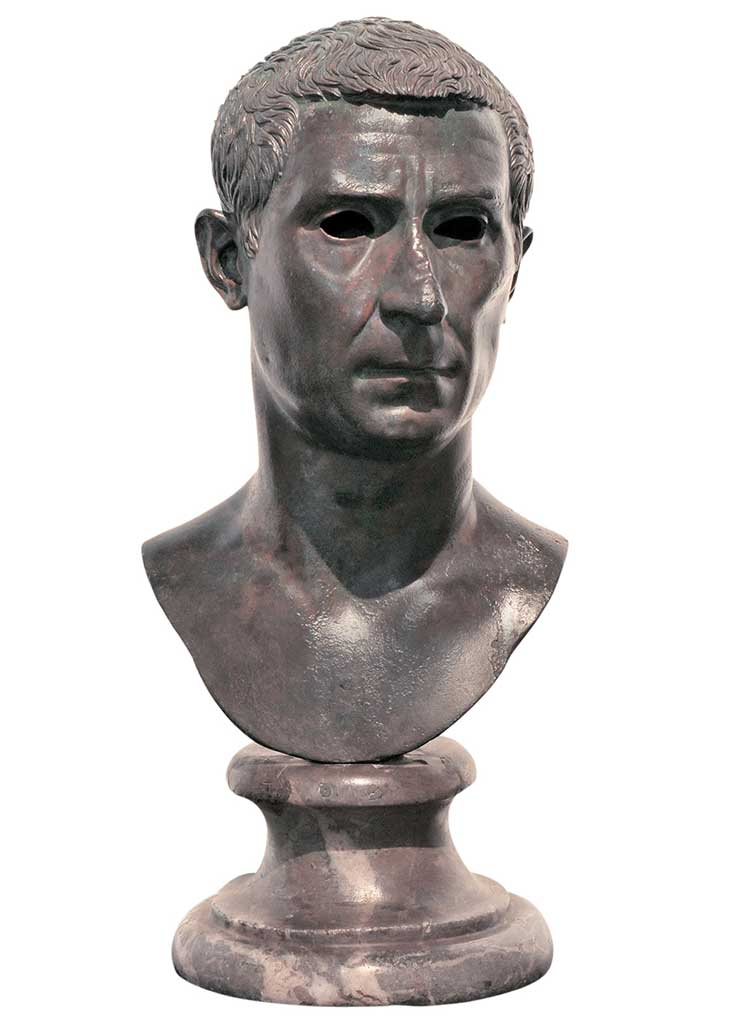
Bust of Lucius Calpurnius Piso Caesoninus Pontifex (15 BC–33 AD), Roman. Photo: Giorgio Albano; courtesy Museo Archeologico Nazionale di Napoli
In one of his epigrams, Philodemus invites Piso to a feast at his humble ‘cottage’ in honour of Epicurus’s birthday. He delicately contrasts the luxury of Piso’s table, with its ‘sow’s udders and toasts of Chian wine’, with the simplicity of his own. At the same time, he flatters his patron’s intellect by alluding to the Odyssey and suggesting that Piso will appreciate the learned conversation of the Greek Epicurean community. This epigram, like the villa’s wall paintings, implies that wealthy Romans such as Piso, who studied Epicureanism in their leisure time, incorporated it into their own lives in a less thoroughgoing way than those observed by their poorer tutors from Greece, for whom philosophy was both a profession and a way of life.
Another sign that the villa’s owner was a less than fully committed Epicurean is the presence, among the villa’s statues, of more than a dozen herm busts of kings and queens from the eastern Mediterranean of the Hellenistic period, such as, for example, that of Demetrios Poliorketes, king of Macedon, which was found in the larger peristyle garden. They may have been intended to function as models of the proper (and improper) behaviour of the Greek ruling class. The villa’s owner could reflect on their successes and failures before returning to his political career in Rome. As a symbol of the glory and responsibility of ruling, the busts are inconsistent with Epicurus’s command to ‘keep out of politics’. However, Piso and other Roman Epicureans seem simply to have ignored this rule, which did not fit with their public careers. Philodemus went along with his patron: the treatise he dedicated to Piso is an un-Epicurean ‘mirror for princes’, in which Demetrios Poliorketes and other rulers are compared negatively with Homeric ideals of kingship. We can imagine Philodemus and Piso strolling through the colonnades, pondering the excesses and downfalls of the monarchs before them, and tactfully avoiding comparisons with Piso’s son-in-law.
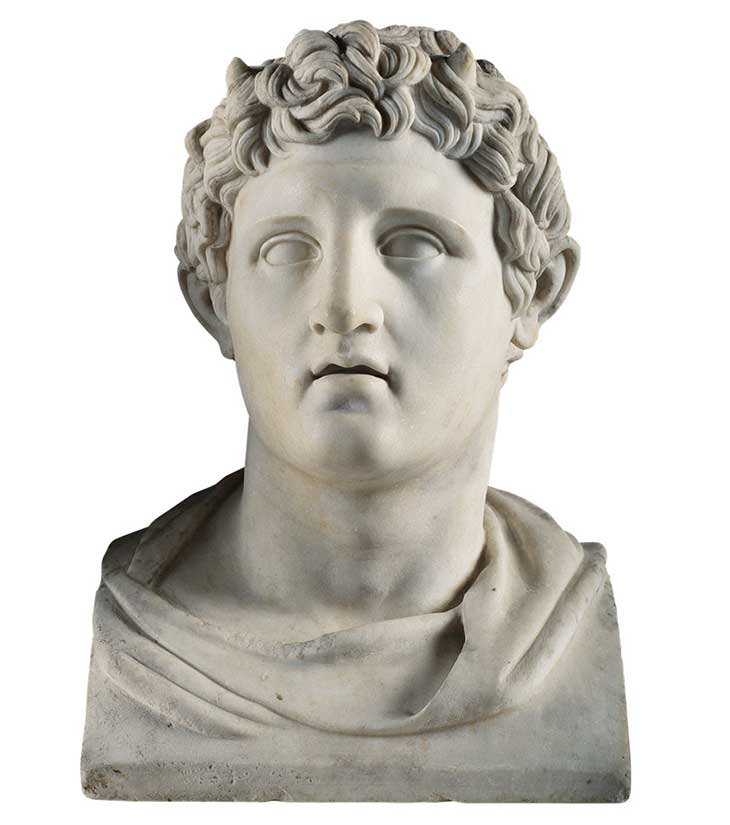
Bust of Demetrios Poliorketes (1st century BC–1st century AD), Roman. Photo: Luigi Spina; courtesy Museo Archeologico Nazionale di Napoli
The Roman poet Lucretius, also an Epicurean, was a much sterner critic of his aristocratic patron Memmius than Philodemus was of Piso. Lucretius uses Epicureanism to satirise Roman society, which he perceived as corrupted by a feverish obsession with extravagance and political power. The fact that Lucretius could have such a different interpretation of Epicureanism from Piso, his contemporary, demonstrates that Greek thought, like Greek art, was not simply imported wholesale into Roman culture. Instead, individuals could pick and choose from it according to their needs.
But Lucretius would surely have approved of some aspects of the Villa dei Papiri – in particular, the belvedere. ‘It is pleasant,’ he says, ‘when the winds are stirring up the waves of the great sea, to watch a shipwreck from the safety of the land.’ The villa would have been an ideal spot for philosophical contemplation – even if its owner, summoned back to business in Rome, would not always have been there to enjoy it.
‘Buried by Vesuvius: Treasures from the Villa dei Papiri’ is at the Getty Villa, Pacific Palisades, CA, until 28 October.
From the June 2019 issue of Apollo. Preview the current issue and subscribe here.
Unlimited access from just $16 every 3 months
Subscribe to get unlimited and exclusive access to the top art stories, interviews and exhibition reviews.

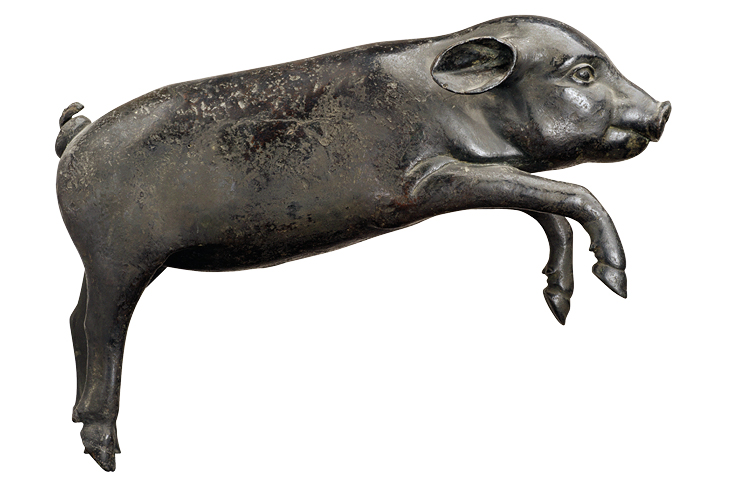
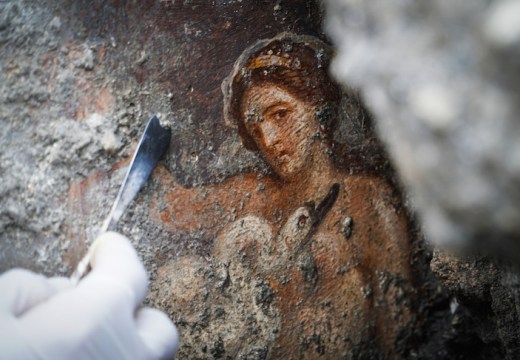
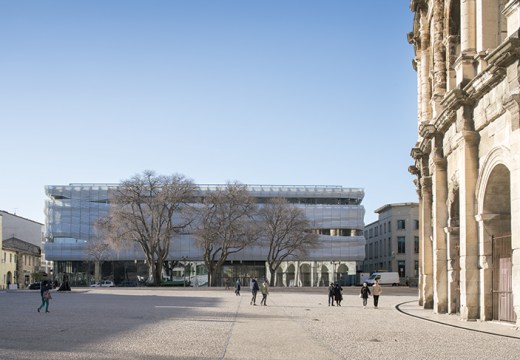










![Masterpiece [Re]discovery 2022. Photo: Ben Fisher Photography, courtesy of Masterpiece London](http://www.apollo-magazine.com/wp-content/uploads/2022/07/MPL2022_4263.jpg)
It’s time for the government of London to return to its rightful home